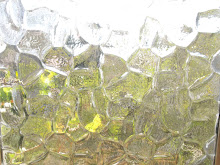

I have this fantasy of returning to Detroit, walking through its neighborhoods photographing abandoned buildings and climbing through them. I imagine all the hidden subcultures and underground scenes thriving in the urban wasteland - artists and grafitti and urban gardens. Anywhere that society is coming apart at the seems, where no one cares what you do with the physical space, is bound to produce incredible creative projects. When there's no one to tell you you can't do something, or you shouldn't, people who are inspired and motivated and excited to try out their ideas will flourish. They will slowly emerge from the ruins to reclaim the city.
Growing up in the sterile, wealthy suburbs to the north, Detroit has always held a strong fascination for me. I never explored it when I lived there, except to go down for baseball games, plays and the Thanksgiving parade. Even then, we didn't go more than a block off Woodward. That was the 1990's and parts of Woodward were already lined with abandoned buildings boarded over in plywood.
This film is exactly what I would want to be doing if I were in Detroit right now. It captures the exact moment and place in history that Detroit embodies. Detroit is in many ways the pulse of the nation, or, if not that, then the throat culture taken to determine the sickness. For so many decades, as Detroit went, so did America - and now it's a ruin; it's a monument to times past, left for the archeologists of future civilizations. But there are still people living in the city, and some things are thriving.
The documentary begins and ends on Eminem, native son. The soundtrack, fittingly, is incredible. Detroit was always a locus for great music, the Motown Sound. The film goes from Eminem to Woody Guthrie to Public Enemy to Frank Sinatra, Martha and Vandellas and the MC5.
There are some interesting recurring cinematic techniques that are used well by the filmmakers. The projection of old footage onto the sides of now abandoned buildings is an especially powerful strategy. Everything from a music video filmed in a Ford on the working assembly line to the 1969 riots, washed ghostlike across overgrown and crumbling edifaces. It's powerful. Additionally, almost all of the interviews take place in moving vehicles or while breaking into and exploring abandoned buildings. Many of the car interviews are disconcertingly interrupted by people in the surroundings screaming, shouting, drivers-by leaning out the window to finish chugging a tall boy in a paper bag, etc.
Detroit is an amazing place and a powerful microcosm of America itself. This country never rolled like it did after the war when industrial production was booming and the middle class was growing. The unions were strong and whether the Big Three liked it or not, they were funding a livable reality for thousands of workers. But the old sins were always there under the surface.
The workers came from across the country to Detroit, and with them came the old racial divides of the South. Not that the North was a post-racial world by any means; the KKK was active in Royal Oak, where my father grew up, and neighboring Berkley. The riots in 1967 were enormous and Detroit was never the same, but all that really happened was the White/Black line that had been drawn within the city's border became the city's border. We grew up about 10 miles north of 8 mile (made famous by the Eminem movie - the northern border where Detroit meats Ferndale), and there were maybe a dozen black kids in my high school of 1100.
The suburbs are surprisingly wealthy given Detroit's abject poverty. Oakland County, where I grew up, is ranked 26th in the nation by per capita income (according to Wikipedia), and Bloomfield Hills, my suburb, has a per capita income of over $100,000. There's serious money not 10 miles outside Detroit's border.
This documentary captures the rise and fall of one of the greatest cities America ever built. Detroit is the epicenter of American industrial might, the place where we "turned these dreams and desires into sheet metal." The footage exploring abandoned buildings and factories is captivating, the music is compelling and the narrative flows as smooth as a Cadillac. I especially appreciate the note that the film ends on: Ex-cons working for Goodwill to salvage the abandoned builings, urban gardens croping up in their wake.
Requiem for Detroit - 75 min.
http://www.youtube.com/watch?v=2OpXhd7iau8

3 comments:
OMG, I can't wait to watch this. I enjoy your writing, by the way. Bonnie and I have five mutual days off to take a vacation this summer and my daydream is to explore Detroit. To convince her we'd need some sort of outdoorsy camping / hiking adventure. Suggestions??
Also, checkit:
http://www.archdaily.com/60921/roll-it-experimental-housing-university-of-karlsruhe/
See also: http://www.marchandmeffre.com/detroit/index.html
Post a Comment